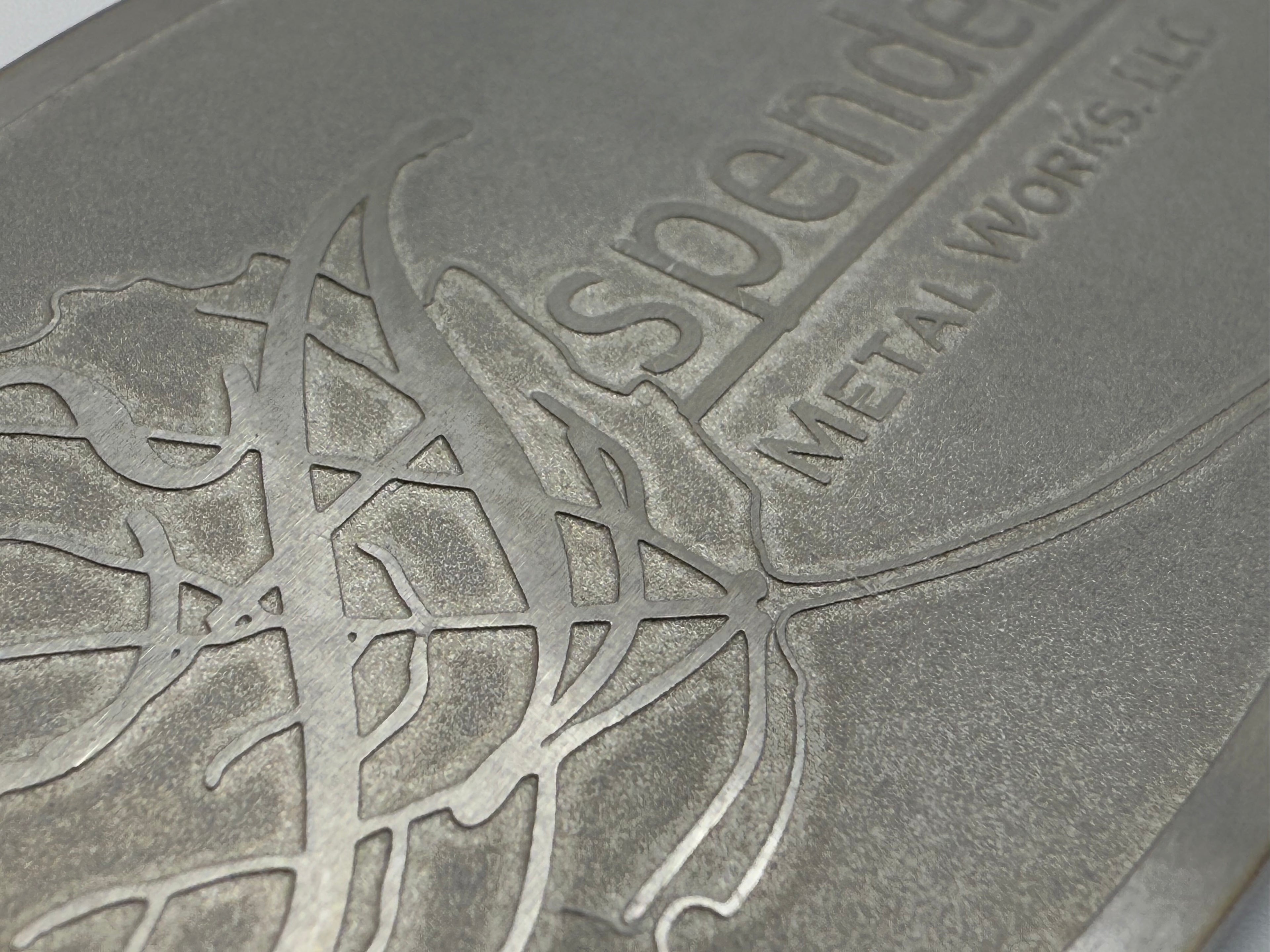
What Is Chemical Etching?
Chemical etching (also called photochemical etching or chemical milling) is a subtractive manufacturing process that uses a photoresist mask and corrosive chemicals to selectively dissolve parts of a metal sheet, without applying heat or force. It’s valued because it produces complex, burr-free details with tight tolerances, preserves the metal’s mechanical properties, and works well even on hard or delicate metals like stainless steel.
What Are The Benefits Of Chemical Etching?
Design With Precision
Metal etching can achieve designs with extremely fine lines, intricate patterns, and sharp edges that are difficult with stamping or machining.
Low Tooling Costs
Since the process doesn’t require hard tooling or dies, it may be more cost-effective for short runs, prototypes and complex designs.
Limitless Creativity
Select from brass, copper, stainless steel or aluminum and add eye-popping colors using automotive grade paints or anodized finishes on aluminum.
Extreme Durability
All of our materials promise strength, but stainless steel is the material of choice for logo's needing to survive in the world’s harshest conditions.
How Does Chemical Etching Differ From Engraving?
Chemical Etching
Process
Uses chemical reactions (acid or etchant + mask/photoresist) to dissolve exposed metal areas.
Precision/Detail
High precision manufacturing, can do very intricate patterns with minimal mechanical stress.
Depth
Usually shallow, surface-level depth; fine detail and very crisp surface.
Costs
Generally more cost-effective for intricate or large-volume work. Tooling (photo masks) is cheaper than hard cutting tools in many cases.
Durability
Very durable, especially on metals as markings are permanent though shallow etches may wear more over time if exposed to heavy abrasion.
Engraving
Process
Physically cuts into the material using tools (hand, rotary, or laser), removing material.
Precision/Detail
Good precision with lasers, but may be less suitable for extremely fine details.
Depth
Offers deeper cuts/grooves with textural, tactile depth.
Costs
Higher cost when designs are intricate, options for depth vary. More tool wear or machine time adds to cost.
Durability
More durable physically because the cuts are deeper. Better resistance to abrasion, scraping, heavy wear.
Explore Etched Products
-
 Quick Quote
Quick QuoteEtched Badges
-
 Quick Quote
Quick QuoteEtched Tags
-
 Quick Quote
Quick QuoteEtched Namplates
-
 Quick Quote
Quick QuoteEtched Decorative Trim
What Materials Can Be Photo Etched?
Etched Stainless Steel
Stainless steel etching offers unmatched toughness and is the most suitable option when longevity and corrosion resistance are critical. Product designs can be enhanced with rich, bold colors in recesses using automotive-grade paints or soft enamels.
Average Depth: .004"~.008"
Etched Brass
Brass etching delivers a warm, timeless look tailored to enhancing a product’s perceived value. It is the ideal material when luxury is the primary goal. Add vibrant colors in recesses using automotive-grade paints or soft enamels.
Average Depth: .004"~.008"
Etched Aluminum
Aluminum etching is the best choice when you need a cost-effective, lightweight option with plenty of ways to customize. More affordable and lighter than other metals, it provides a sleek finish, with colors added through anodizing for a modern, lasting effect.
Average Depth: .002"~.005"
Etched Copper
Copper etching, similar to brass, delivers a warm, natural tone with a rich patina that deepens over time. It is the most expensive material used for premier products, yet also the least used, making it a rare choice that instantly signals exclusivity.
Average Depth: .004"~.008"
In the automotive industry, etching is commonly used for interior and exterior nameplates, dashboard trim, emblems, fuel cell plates, and precision filters. The process allows these products to be developed with intricate details and a premier surface finish that can withstand the most demanding enviornments.
Etching is widely used for crafting printed circuit boards (PCBs), IC interconnects, MEMS sensors, and delicate filters with micro-scale precision that is difficult to replicate with other methods. It also enables the creation of richly designed cover plates and branded badges, helping draw eyes to your products and driving long-term sales.
Bring to life elegant bottle labels, premium packaging accents, neck embellishments, plaques, and inserts, helping enrich brand identity. When combined with stunning colors, unique textures, and creative patterns, etched details make products impossible to ignore on the shelf. Softly shape the way consumers view your products and drive long-term sales.
In the medical industry, even the smallest deviation isn’t just a defect, it can be the difference between life and death. That's why precision plays such a vital role. Deliver intricate, burr-free components for tiny diaphragms, microfluidic channels, electrodes, sensor parts and logo badges with tight tolerances. Because this process preserves material integrity (no heat warping, no microscopic stress), devices like implants, diagnostic tools, and surgical blades perform reliably inside the body, where even the smallest flaw can lead to serious consequences.
Check Out Some Of Our Work
Frequently Asked Questions
What is the process of etching?
A controlled method of removing metal with chemicals to create fine, permanent designs.
A sheet of metal is first cleaned and coated with a protective photoresist. The desired pattern is transferred onto the surface, leaving selected areas exposed. When the metal is placed in a solution, the exposed sections dissolve away with extreme precision, forming recessed lines, textures, or shapes.
Afterward, the resist is removed and the part is cleaned, leaving a crisp design that can be filled with paint or enamel, anodized (aluminum), milled or finished for added durability.
Because the material is dissolved rather than cut or stamped, you are able to achieve high accuracy, no mechanical stress, and design freedom that makes it ideal for industrial components, decorative trim, logos, and more.
How much does etching cost?
The cost depends on several factors, including the type of material, material thickness, complexity of the design, desired etch depth, and additional finishing or color options.

















